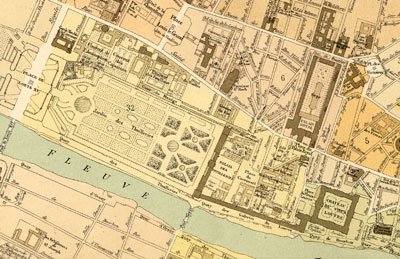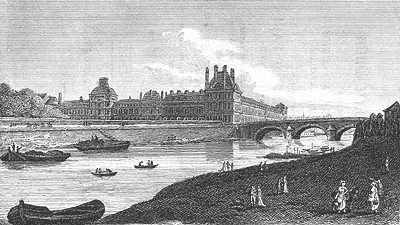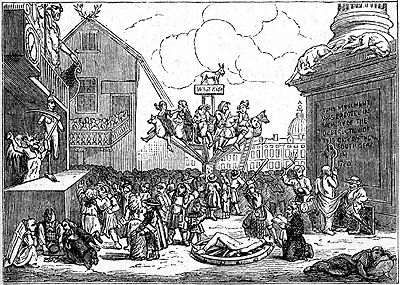|

NOTES ON ISSUE 5: GLOSSARY
PART 3 OF 4
The exquisite
gentlemen of the finest breeding wore little pendent trinkets
that chinked as they languidly moved; these golden fetters rang
like precious little bells: and what with that ringing, and
with the rustle of silk and brocade and fine linen, there was
a flutter in the air that fanned Saint Antoine and his devouring
hunger away.
In the 18th century, men’s fashions – in both wigs
and clothing – were as elaborate as women’s. Aristocratic
men wore a considerable amount of jewelry – multiple watches,
fobs, chains, seals, and so forth (Fairholt 605) – and
their clothing was made of materials as fine as that of their
female counterparts. Brocade is a rich, stiff fabric –
“A textile fabric woven with a pattern of raised figures,
originally in gold or silver; in later use, any kind of stuff
richly wrought or ‘flowered’ with a raised pattern”
(OED). And “fine linen” refers not only
to the material known as “linen,” but to the articles
most frequently made of it – underclothing, shirts, and
so forth (OED).
From the Palace of the Tuileries…
The Palace of the Tuileries (or, in French, Palais des Tuileries),
which no longer exists, was erected by Catherine de Medici in
1564 as a royal residence (Tronchet 95); until the period of
the French Revolution, however, it was only sporadically occupied
by French monarchs. Standing opposite and to the west of the
Louvre, the original building was named “les
tuileries” after the field of tile-kilns it displaced.
It was later extended to the north and south under Henri IV
and Louis XIV, reaching further toward and away from the Seine.
By the pre-revolutionary period described in this part of A
Tale of Two Cities (1780), the Palais des Tuileries had
been connected to the Louvre by the erection of a wing along
the bank of the Seine. The space between the two buildings –
joined now on the river side – was, “with the exception
of the court-yard in front of the [Palais des Tuileries], …
occupied at the time of the [French] Revolution, and down to
nearly the middle of the [19th] century, by a labyrinth of narrow
streets” (Baedeker 151). The Palais des Tuileries, the
Louvre, and the warren of little streets between them are all
visible on this portion of the Plan de la Ville de Paris
en 1789, which maps pre-revolutionary Paris.

Click
on map for larger view
The palace, as a historical site, is extremely important in the context
of the French Revolution: Louis XVI was forced to lodge in the Palais
des Tuileries from October 6, 1789 onward, in response to the call of
the people for “Le Roi à Paris” – “the King to Paris”
(Carlyle 239-43). Moreover, when he and his family attempted to escape
from Paris in June, 1791, they were returned (after the failure of that
escape attempt) to the Tuileries. Dickens’ passing references to the
Tuileries in A Tale of Two Cities are thus evocative of some of
the most significant events of the revolutionary period in France.

This illustration, taken from Tronchet’s
Picture of Paris (c. 1818), gives us some idea of what
the Palais des Tuileries would have looked like in the period
described by Dickens. With the Seine in the foreground, the
illustration gives us a view of the western side of the palace,
with the wing connecting to the Louvre stretching off into the
distance. In 1780, the palace would have looked much like this
from this perspective.
Expanded under Napoleon, the Palais des Tuileries was all but destroyed
in the fall of the Paris Commune of 1871, when it was torched by the
Communists on May 22-23. Today, the site of the original palace of
Catherine de Medici is marked only by the underpass Avenue du
Gal-Lemonnier (Baillie and Salmon 90), and the mess of streets that
existed between the palace and the Louvre in the 18th and early 19th
centuries is now supplanted by the gardens of the Jardin du Carrousel.
…the Fancy Ball descended to the Common Executioner
who, in pursuance of the charm, was required to officiate ‘frizzled,
powdered, in a gold-laced coat, pumps and white silk stockings.’
Dickens’ source for the uniform of the Common Executioner is Mercier’s Tableau
de Paris (1781-8), in which it is noted that this functionary was
“curled, powdered, braided, in white silk stockings, [and] in flats”
(qtd. in Sanders in the French 86).
At the gallows and the
wheel – the axe was a rarity – Monsieur Paris, as it was the episcopal
mode among his brother Professors of the provinces, Monsieur Orleans,
and the rest, to call him, presided in this dainty dress.
In pre-revolutionary France, execution
by the axe (decapitation) was reserved for aristocratic transgressors;
the poor were hanged, or, for offenses considered particularly heinous
(like parricide), were broken on the wheel (Sanders 86). Given the
aristocratic associations of the axe (to which Dickens alludes when he
remarks that it was “a rarity”), the guillotine – which became the mode
of execution for all victims of the French Revolution – was
originally considered an egalitarian development, making the blade
available to all. This 18th-century caricature, from the Book of
Days (1864), shows a man being “broken on the wheel” in the
foreground.

Dickens’ reference to the “episcopal
mode” rephrases his source (Mercier’s Le Nouveau
Paris [1799]), which notes that “Entr’eux ils s’appellent (à l’instan
des èvêques) Monsieur de Paris, Monsieur
de Chartres, Monsieur d’Orléans” (qtd.
in Sanders 86). A bishop is an ecclesiastical authority responsible
for overseeing church government in a particular diocese –
a spiritual guide and administrator, ranking above priests and
deacons, and often referred to according to his office and the
area within his jurisdiction (for example, “Bishop of
Paris” or, in French, “Èvêque de
Paris”).
The fashion of calling executioners
after their home districts in the “episcopal mode” suggests not only
that a grisly secular authority contended, in this period, with
religious authority, but (given Dickens’ emphasis on the “dainty dress”
of “Monsieur Paris” and his provincial brethren) that the executors of
human fate (spiritual and secular) were given over to a frivolity
inconsistent with their offices. The powers and abuses of the clergy
were disputed before the Revolution, and the Revolution itself saw, not
only the temporary secularization of Roman Catholic France, but the
confiscation of church lands and severe modifications of church
authority.
…and his snuff-box in his hand, slowly passed among
the mirrors on his way out.
The practice of taking snuff – a kind of powdered tobacco which was
inhaled through the nostrils (OED) – became fashionable in the
17th century (in about 1680, according to the OED), and
continued to be popular through the 18th century. A snuff-box is a
receptacle for snuff, usually portable, and often ornamental (like
Monsieur’s, which contributes to his general ostentation). By the 19th
century, though snuff was still taken, it began to be perceived as a
pernicious habit. The Dictionary of Daily Wants (1859) gives
the following admonitions concerning
SNUFF-TAKING, INJURIOUS EFFECTS
OF. – This habit is extremely injurious, and a common cause of
dyspepsia. It is a pretty well-ascertained fact, that where snuff is
taken in large quantities, a great portion enters the stomach, and as a
matter of course seriously impedes the functions of that organ. Some
snuffs produce more injurious effects than others, and this is the case
with the highly perfumed, and damp heavy kinds. The least injurious
kind is probably what is called the high-dried Irish or the Welsh
snuff, for in the roasting of these, some of the narcotic principle is
destroyed; therefore, a few pinches occasionally will not do much harm.
But, however desirable it may be for a person to wean himself from this
habit, still the confirmed snuff-taker should be cautious not to
abandon the indulgence all at once, but to lessen the quantity
gradually until it is finally abandoned. The reason for this is, that
the system, after being so long accustomed to its stimulant, might flag
under the withdrawal of it, and occasion serious illness. There are
other reasons why snuff-taking should not be indulged in; it is an
offence against cleanliness; it is disagreeable to other persons with
whom the snuff-taker may be brought in contact; and it occasions a
great waste of time. (921)
At last, swooping at a street
corner by a fountain, one of its wheels came to a sickening little jolt…
The hazardous driving of Monsieur the Marquis’ carriage is, according
to a chapter in Mercier’s Tableau de Paris (1781-8),
historically accurate. In an anecdote called “Gare! Gare!” (“Watch out! Watch
out!”), Mercier describes the perils of the Parisian roads in this
period and the indifference of the wealthy to the consequences of their
haste:
Watch out! Watch out for
carriages! [writes Mercier]…. I have been knocked over three times on
to the street at different periods, and in each case I was almost
broken on the wheel. I therefore can claim a little bit of moral
authority when I condemn the barbarous luxury of carriages.
No one’s put the brake on, despite the daily complaints. The menacing
wheels which proudly hold up the rich fly no less rapidly over a
pavement stained with the blood of unfortunate victims who expire in
frightful tortures, awaiting the reform which will not come, because
all those who participate in the administration maintain state-coaches,
and consequently disdain the complaints of the infantry.
The lack of sidewalks makes almost all the streets perilous: when a man
who has a little credit gets sick, they spread dung in front of his
door, to muffle the sound of state-coaches; and it is then above all
that one must be on guard…. When a coach has ground you up alive, they
ask at the police superintendent’s office if it is the big wheel or the
little wheel that did it; the coachman says the little; and if you
expire beneath the big wheel, there are scarcely any pecuniary damages
paid to your heirs. There is a fine for the arms, the legs, the thighs;
and it is a price set ahead of time. (qtd. in and translated by
Maxwell, 410-11)
He threw out a gold coin for
the valet to pick up…
The gold coin tossed here, in 1780, is probably a louis
d’or. (A reference to its identity as “that
Louis” exists in the manuscript version of A Tale
of Two Cities, though the phrase “Who threw back
that Louis?” was revised by Dickens to “Who threw
that?” before publication.) The louis d’or,
first minted in 1640 under Louis XIII, was current through the
reign of Louis XVI. The reforms of the Revolution introduced
decimal coinage beginning in 1795, and though the name louis
d’or has since been applied to other French coins
(such as the 20 franc piece, or Napoleon), the original golden
louis expired with
the Revolution. In the pre-revolutionary period, the louis
d’or was worth slightly less than an English pound
(OED), and the chief monetary units were the louis
d’or (a gold coin worth about 4 écus
in this period), the écu (a silver, or sometimes a gold
coin, worth about 6 livres),
the livre (worth 20
sous), the sou (worth 4 liards),
the liard (worth 3 deniers) and the denier
(a copper coin of very small value). After the introduction
of decimal coinage, the “sou” was retained as the name of a 5-centime
piece (100 centimes equaled 1 franc), just as the louis
d’or was retained as a name for the 20 franc piece.
…the one woman who had stood conspicuous, knitting,
still knitted on with the steadfastness of Fate.
In mythology, Fate is the goddess (or one of the goddesses) of destiny.
In Greek mythology, the Fates were a trio of goddesses – Clotho
(“spinner”), Lachesis (“measurer”), and Atropos (“inexorable”). Clotho
was said to spin the thread of life, Lachesis to draw it out to a
certain length, and Atropos to cut it off. In light of this tradition
of “spinning,” the knitting of Fate-like Madame Defarge echoes the
vocation of her classical predecessors.
…on inanimate nature [the fields], as on the men
and women who cultivated it, a prevalent tendency toward an appearance
of vegetating unwillingly – a dejected disposition to give up, and
wither away.
In the years just before the French Revolution, crop failures (as a
result of bad weather and droughts) contributed to the poverty and
hunger of the poor, especially among the peasant laborers of the French
countryside. Dickens’ account of the withering of vegetation and people
is probably based upon Arthur Young’s accounts of agricultural
depression in his Travels in France During the Years 1787, 1788,
and 1789 (1792), and upon passages in Carlyle’s French
Revolution. Dickens is, in this portion of A Tale of Two
Cities, representing the agricultural conditions of 1780; however,
continued failures – especially those of 1788 – figured among the
causes of the Revolution:
On the 13th of July, … 1788, there
fell, on the very edge of harvest, the most frightful hailstorm;
scattering into wild waste the Fruits of the Year; which had otherwise
suffered grievously by drought. For sixty leagues round Paris
especially, the ruin was almost total. To so many other evils, then,
there is to be added, that of dearth, perhaps of famine. (Carlyle 91)
A year and a day later – July 14, 1789
– the Bastille was besieged.
…poor tannery, poor tavern, poor stable-yard for
relays of post-horses, poor fountain, all the usual poor appointments.
A tannery is a place in which skins or hides are converted into leather
by “steeping [them] in an infusion of an astringent bark, as that of
the oak, or by a similarly effective process” (OED). Post-horses are those “kept
at a post-house or inn for the use of post-riders, or for hire for the
conveyance of travelers” (a post-house being an “inn or other house
where horses are kept for the use of travelers” [OED]). The name comes from the
original “postal” function of these way stations and relay horses (by
means of which the mails were conveyed from stage to stage across the
country before the advent of swifter conveyances like the railway). A
“poor fountain” would be the “usual poor appointment” of a French
village or city because water – being the chief beverage of the poor –
would make a fountain a gathering place (Maxwell 455).
…the tax for the state, the tax for the church, the
tax for the lord, the tax local and tax general, were to be paid here
and to be paid there, according to solemn inscription in the little
village, until the wonder was, that there was any village left
unswallowed.
One of the chief grievances of the poor in pre-revolutionary France was
the exorbitant and unequally levied set of taxes to which the common
people were subject. Ironically, the greatest number of taxes fell upon
the poorest of the French, while the aristocracy and clergy resisted
taxation. For example, in 1776, the Controller-General of Finance
suggested that the nobility and clergy should be taxed in order to help
remedy the growing French national deficit; his advice met with so much
indignation that the taxes were not imposed, and he himself was
dismissed (French Revolution xxxii). As Carlyle describes this
state of affairs,
Such are the shepherds of the people: and
now how fares it with the flock? With the flock, as is inevitable,
it fares ill, and even worse. They are not tended, they are
only regularly shorn. They are sent for, to do statute-labour,
to pay statute-taxes; to fatten battlefields (named “bed
of honour”) with their bodies, in quarrels which are not
theirs; their hand and toil is in every possession of man; but
for themselves they have little or no possession. Untaught,
uncomforted, unfed; to pine stagnantly in thick obscuration,
in squalid destitution and obstruction: this is the lot of the
million…. (13)
In addition to Carlyle, Dickens
probably referred to Arthur Young’s Travels
in France During the Years 1787, 1788 and 1789 (1792) to flesh
out his account of pre-revolutionary conditions in the French
countryside. Young, like Carlyle, attributes some of the revolutionary
fervor of the poor to excess taxation:
The abuses attending the levy of
taxes were heavy and universal. Instances and even gross ones, have
been reported to me in many parts of the kingdom, that make me shudder
at the oppression to which numbers must have been condemned…. [W]hat
must have been the state of the poor paying heavy taxes, from which the
nobility and clergy were exempted? A cruel aggravation of their misery,
to see those who could best afford to pay, exempted because able. (qtd.
in Sanders 91)
|

